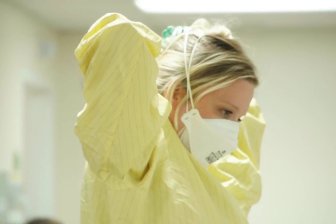This weekend marks the first Thanksgiving weekend since nearly all public health measures in Alberta were dropped.
With gatherings planned provincewide, how can families serve Thanksgiving dinner without a side of COVID?
“If it is a group of people where there might be some members who are at higher risk of severe disease because they’re older, have multiple medical conditions, have any immune problems, looking to have at least part of the gathering outdoors does make a difference. And if indoors, opening the windows could make a difference,” Dr. Lynora Saxinger, an infectious diseases specialist at the University of Alberta, said.
The clinician added people of any age taking medication for medical conditions, the very young and the under-vaccinated are at risk of severe disease.
Less than a month into the new school year, dozens of schools have been placed on respiratory illness outbreaks and 2022 has seen children hospitalized by COVID at a higher rate than the two previous years of the ongoing pandemic.
Saxinger said recent exposure to the virus via booster shot or infection reduces the likelihood of severe disease, hospitalization or death.
“But of course, that doesn’t mean that a non-severe illness is a walk in the park,” she said, adding getting a booster shot days before attending a dinner can still help with individual protection.

Saxinger said anyone with cold- or flu-like symptoms should avoid social gatherings. And getting a COVID-positive result in a rapid test can confirm if someone is contagious with COVID-19.
“If they have symptoms and they test COVID-negative, I don’t necessarily think that that’s as reassuring as people might imagine it is. If people are feeling fine and then the rapid test is negative, that definitely should make that a safer gathering,” she said.
“If you’re going to use a rapid test, it shouldn’t change your basic precautions. That doesn’t mean you should be getting all up in each other’s faces because ‘you’re completely safe.’ It just means that it should be a screen-out test so that people who are positive know and don’t go in.”
The air we breathe
The same substance that carries the scent of a freshly-roasted turkey can also carry the virus that has killed more than 4,900 Albertans during the pandemic: air.
“Laboratory, field, modeling and case studies have demonstrated that airborne transmission via inhalation of virus-laden aerosols is important, if not dominant, for COVID-19,” The Lancet’s commission on COVID-19 wrote.
Organized by the prestigious medical journal The Lancet, the commission was created to provide a comprehensive investigation, analysis and response to COVID-19, publishing its final report in mid-September.
Its task force on COVID safety laid out four key strategies to reduce indoor transmission of the coronavirus.
The first was to make sure a building’s HVAC system is working properly. In most homes, that’s the furnace.
The second is to maximize outdoor air, either through mechanical ventilation with the HVAC system or by doing things like opening windows. The idea is to increase the number of times the air is exchanged in an hour.
“Higher ventilation rates of… four to six air changes per hour have been proposed to reduce the risk of airborne infectious disease transmission indoors,” the Lancet’s commission wrote, recognizing people might get uncomfortable keeping doors and windows open on very hot and very cold days.
The third is to upgrade air filtration in HVAC systems to the minimum efficiency reporting value (MERV) 13 standard. Many home furnace filter sizes are available in the MERV 13 standard.

And the fourth strategy is to supplement areas with portable high-efficiency particulate air (HEPA) air filtration units.
“Properly sized portable air cleaners with HEPA filters can reduce in-room concentrations
of airborne particles, including those carrying viral material,” the Lancet commission’s report reads.
The commission also said indoor air quality or carbon dioxide monitors can be set up to create a measure of fresh air in spaces.
Looking at the wastewater
Wastewater testing for SARS-CoV-2 particles measures the prevalence of COVID-19 within a community.
Michael Parkins, an infectious disease clinician, scientist and assistant professor at the University of Calgary, said there currently seems to be no clear upward trends in the 21 different cities and areas the provincewide team tests.
But that doesn’t mean there’s no risk of catching COVID right now.
“We have more (wastewater) SARS-CoV-2 at a baseline level now than we did through any of our wave one or wave two and almost as high as we had through our wave three,” Parkins said. “So though we’re not in a peak, our baseline is very high right now.
“So at-risk populations still need to be protected.”
He also noted that BA.4/5 appears to continue as the dominant subvariant in the province.

“What we have seen in the past quite clearly is with new variants coming in, we see a switch from the prior endemic strain to the new emerging strain, and with that immediately, as soon as that change happens, virus levels start to increase and cases take off,” Parkins said.
“Certainly, we expect that at some point. How soon? We don’t know.”
No new provincial data
Ahead of the regularly-scheduled release of weekly COVID-19 data by the province, chief medical officer of health Dr. Deena Hinshaw informed Albertans of delays in releasing new numbers.
“Unfortunately, we have experienced a data flow problem that is preventing us from updating our data this week,” Hinshaw tweeted.
An Alberta Health spokesperson confirmed their teams are experiencing technical issues and are working to resolve them.
Hinshaw expected to have data for the week ending Oct. 3 to be available in the following week’s report.
“We know this is frustrating for Albertans who use this information to better understand COVID-19 spread. We remain committed to providing accurate and factual information, and until the data flow issue is resolved, we cannot do this.”




Post a Comment